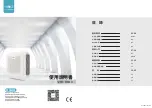
24
5. Purge the air from the system using vacuum pump for about 10 minutes.
f
Close the valve of the low pressure side of manifold gauge clockwise.
f
Make sure that pressure gauge shows -0.1 MPa(-76cmHg) after about 10
minutes. This procedure is very important to avoid a gas leak.
f
Turn off the vacuum pump.
f
Remove the hose of the low pressure side of manifold gauge.
6. Turn the liquid and gas service valves to the open position by turning
counterclockwise.
7. Mount the valve stem nuts and the service port cap to the valve, and tighten
them at the torque of 158.8 lbf•in with a torque wrench.
8. Check for gas leakage.
f
At this time, especially check for gas leakage from the 3-way valve’s stem
nuts(A port), and from the service port cap.
B(liquid)
A(gas)
• Connect the indoor and outdoor units using pipes with flared connections (not supplied). For the lines, use
insulated, unwelded, degreased and deoxidized copper pipe, (Cu DHP type to ISO 1337 or UNI EN 12735-1),
suitable for operating pressures of at least 4200 kPa and for a burst pressure of at least 20700 kPa. Copper pipe
for hydro-sanitary applications is completely unsuitable.
• For sizing and limits (height difference, line length, max. bends, refrigerant charge, etc.) see “Connecting
refrigerant pipe section”.
CAUTION
Connecting to the system and removing air in the circuit
Содержание AC030MXSCCC
Страница 38: ......















































